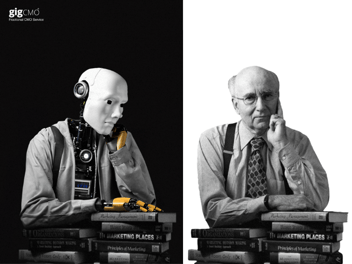
This year’s award for the most overused phrase has to go to: ‘these uncertain times’. This little nugget has been repeated so often and by so many people that it ceases to have meaning, especially considering said ‘uncertain times’ are set to continue, turning them merely into the status quo. That said, these uncertain times have wrought havoc on businesses, not only when it comes to their bottom line but, for many, to the very fibres of their being.
It has brought into question the relevance of what they do, how they do it and whether they will be able to continue doing it moving forward. It is a crisis, not just globally, but strategically for many CEOs, many of whom may be wishing they had a trusted, independent advisor whispering to them if not Jiminy Cricket himself! This individual is someone with a depth of experience, a deep understanding of customer motivations and key drivers of the business. Someone who is outside of the organisation, apolitical, has done it before but is also very objective and trustworthy. At gigCMO we call them a CEO Whisperer. During their career, this individual has navigated their way through the deep uncertainty businesses face in times of crisis. They have managed remote, WFH or distributed organisations. The adjective may have changed but the meaning has not. Their helicopter view, their understanding of the context you operate in sets them apart to help you make the right short-term strategic decisions while re-inventing the business for the future. So if the “Talking Cricket '' wasn't available, what would a CEO Whisperer be saying?
The 11 Dimensions Of Uncertainty
First of all, what, in business terms, do we define ‘uncertain times’? The Economist has written an interesting article in the wake of current circumstances, on managing uncertainty and what uncertainty means in real terms to ‘determine the political and economic environment in which businesses will operate in the period leading up to 2050’. In it they cited 11 ‘dimensions of uncertainty’. Each has an impact on the other, and they include the following:
- Balance of power and governance architecture: Whether increased globalisation will cause countries to veer towards nationalism to protect their power or towards more federal and economic blocs via bilateral and multilateral agreements.
- Economic integration, governance and models: Will global economic shocks help create a global model that is laissez-faire or highly regulated?
- Security and conflict: Will future international and civil wars be fought state versus state, state versus non-state, or non-state versus non-state?
- Science, technology and innovation: Who will own and have the right to benefit from scientific and technology- based innovation? Will new communications technologies lead to the emergence of borderless or virtual communities?
- Education and skills: If, during a period of rapid technological advance, a government simultaneously cuts back on education and professional training funding and restricts immigration, for economic reasons, there are likely to be shortages of skilled labour in key industries.
- Communities: skills availability or lack thereof will have an impact on communities.
- Demographics and migration: The above, in turn, impacts migration trends and policy.
- Health and well-being: On a different note, better-educated individuals are generally more aware of the relationship between lifestyle, diet and health leading to greater consumer demand for products and services supplied by industries that are shaped by or connected to health and well-being.
- Climate change: In turn, all of the above then impacts the value we place on and the attention we give to climate change and…
- Natural resources
- Values and beliefs: Meanwhile, we have already seen a seismic shift in consumer behaviour, the rise of conspiracy theories, the prevalence of anti vaccine movements vs pro vaccine movements, all of which has an impact on who we want in power, which in turn leads back to point 1.
The quoted report’s author concluded:
“Today’s problems can be so immediate and all-pervasive that they can act as blinkers which result in a myopic focus on the present, to the exclusion of a more strategic vision of the future.” Just the time to bring in a CEO Whisperer.
Now, while these things in themselves do not directly correlate to the way a business might manage its own personal crisis amidst global uncertainty, it does two things. Firstly, it sets the scene for the environment in which we are working and the values and challenges that consumers are living by. Secondly, the report author’s conclusion makes an important point in that we need to juggle the immediate task at hand with a longer-term management plan to carry us into the future. It is a challenging journey and one best not undertaken alone.
Reinventing Your Business
You don’t need a CEO Whisperer to tell you that crisis management has two key strands - balancing day-to-day challenges and long-term uncertainty. The Covid-19 pandemic has created some very specific challenges for the everyday, ranging from managing remote working, peer-to-peer communication, supply chain shortfalls and more. However, 10 months or so of that and we need to be taking more than stop gap measures to business management if we want to see 2021.
Such is the task at hand that MIT Sloan undertook a Management Review resulting in five principles for effectively managing a distributed workforce, but also incorporating long term principles that enshrine those concepts into the fabric of the company rather than feeling like stop-gap measures.
They range from creating processes for regular, short communications to enhance a sense of community and connectivity as well as really considering the value and purpose of in-person interactions. All the way to committing to transparency by telling workers what data is being collected and used to measure their contributions now that leadership can no longer “manage by walking around.”
MIT Sloan’s report also cited the need to really commit to flexible work practices by letting employees adjust their schedules to address family responsibilities rather than paying lip service to it as one might have done in the past and using peer networks to improve decision-making.
Brave new world - not the movie but your reality
Of course, business management is not the only thing that your mystical CEO Whisperer might talk to you about if you had one. They would know that the other elements of the business also need to be brought into this strategy for the brave new world.
For example, managing supply chain shortfalls and modified pricing now that we know certain resources or capacity (in hotels for example) are limited. It may mean identifying your responsibilities to the most vulnerable consumers, and let’s not forget how you look to correct any communications and reputation damage that might have occurred at the height of the pandemic.
Naturally, the needs of a business in the wake of such an all-encompassing and wide-reaching period of uncertainty will vary from one to the next. However, the nature of something so vast is that its long-term impact, both collectively and individually, is likely not to really be evident yet.
No doubt it will have an impact, both positive and negative, in ways we cannot yet predict. As such, it serves us all, even those riding high, to take a moment to sense check what we’re doing and how we do it. That way, we can make sure the messages and processes we have in place are properly considered and relevant to the market in which we are now working. It is lonely at the top but it doesn’t have to be.
Find out what a real CEO Whisperer would say to help you drive your business forward for the new environment.




